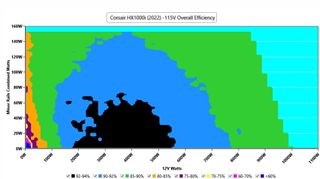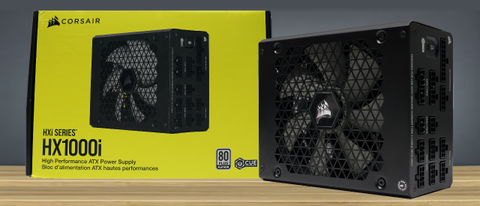Why you can trust Tom's Hardware
Protection Features
Check out our PSUs 101 article to learn more about PSU protection features.
| OCP (Cold @ 28°C) | 12V: 99.4A (119.33%), 12.067V 5V: 34.8A (139.2%), 5.025V 3.3V: 35.3A (141.2%), 3.278V 5VSB: 4.7A (156.67%), 4.818V |
| OCP (Hot @ 41°C) | 12V: 98.6A (118.37%), 12.065V 5V: 33.9A (135.6%), 5.029V 3.3V: 34.7A (138.8%), 3.278V 5VSB: 4.7A (156.67%), 4.815V |
| OPP (Cold @ 29°C) | 1209.41W (120.94%) |
| OPP (Hot @ 45°C) | 1209.37W (120.94%) |
| OTP | ✓ (115°C @ 12V Heat Sink) |
| SCP | 12V to Earth: ✓ 5V to Earth: ✓ 3.3V to Earth: ✓ 5VSB to Earth: ✓ -12V to Earth: ✓ |
| PWR_OK | Proper operation |
| NLO | ✓ |
| SIP | Surge: MOV Inrush: NTC Thermistor & Bypass relay |
The OCP and OPP triggering points are conservatively set, but this is not the case for the minor rails. There is no need for 35A at 3.3V!
DC Power Sequencing
According to Intel’s most recent Power Supply Design Guide (revision 1.4), the +12V and 5V outputs must be equal to or greater than the 3.3V rail at all times. Unfortunately, Intel doesn't mention why it is so important to always keep the 3.3V rail's voltage lower than the levels of the other two outputs.



No problems here since the 3.3V rail is always lower than the other two.
Cross Load Tests
To generate the following charts, we set our loaders to auto mode through custom-made software before trying more than 25,000 possible load combinations with the +12V, 5V, and 3.3V rails. The deviations in each of the charts below are calculated by taking the nominal values of the rails (12V, 5V, and 3.3V) as point zero. The ambient temperature during testing was between 30 to 32 degrees Celsius (86 to 89.6 degrees Fahrenheit).
Load Regulation Charts




Efficiency Graph

Ripple Graphs
The lower the power supply's ripple, the more stable the system will be and less stress will also be applied to its components.




Infrared Images
We apply a half-load for 10 minutes with the PSU's top cover and cooling fan removed before taking photos with a modified Fluke Ti480 PRO camera able to deliver an IR resolution of 640x480 (307,200 pixels).



The hottest part is the board holding the 12V FETs. We didn't notice alarmingly high temperatures during this test. This is an efficient platform; the higher the efficiency, the lower the energy losses.
MORE: Best Power Supplies
MORE: How We Test Power Supplies
MORE: All Power Supply Content
Current page: Protection Features, DC Power Sequencing, Cross-Load Tests and Infrared Images
Prev Page Load Regulation, Hold-Up Time, Inrush & Leakage Current, Efficiency and Noise Next Page Transient Response Tests, Timing Tests, Ripple Measurements and EMC Pre-Compliance Testing
Aris Mpitziopoulos is a contributing editor at Tom's Hardware, covering PSUs.

Lunar Lake's integrated memory is an expensive one-off — Intel rejects the approach for future CPUs due to margin impact

Arrow Lake CPUs can still get bendy despite revamped socket — specialized contact frame flattens chip, claims to lower temperatures by up to 6C

TeamGroup DDR5-7200 C32 CAMM2 promises performance speeds over 100 GB/s — memory manufacturer aims for DDR5-9000
-
Co BIY Another nicely done review. Seems lots of people will need a 1000 Watt supply now.Reply
This is the first time I've heard about PCIe 5.0 having anything to do with the power supply ?
Maybe in the next review you could explain this. -
jkflipflop98 I picked up a 1kw cooler master PSU about 10 years ago or so. It's still going strong.Reply -
escksu ReplyCo BIY said:Another nicely done review. Seems lots of people will need a 1000 Watt supply now.
This is the first time I've heard about PCIe 5.0 having anything to do with the power supply ?
Maybe in the next review you could explain this.
Its not really about the PCIE 5.0 slot but the power connector for graphics card. New graphics cards are supposed to utilise the so-called "PCIE 5.0 16pin power connector" (again, nothing to do with PCIE 5.0 slot).
Eg. the RTX4090 uses PCIE 5.0 16 pin power connector but its actually a PCIE 4.0 16x card.
You do not need any special PSU in order to utlise the PCIE 5.0 slot on your board. Currently there are no PCIE 5.0 devices other than SSD.
